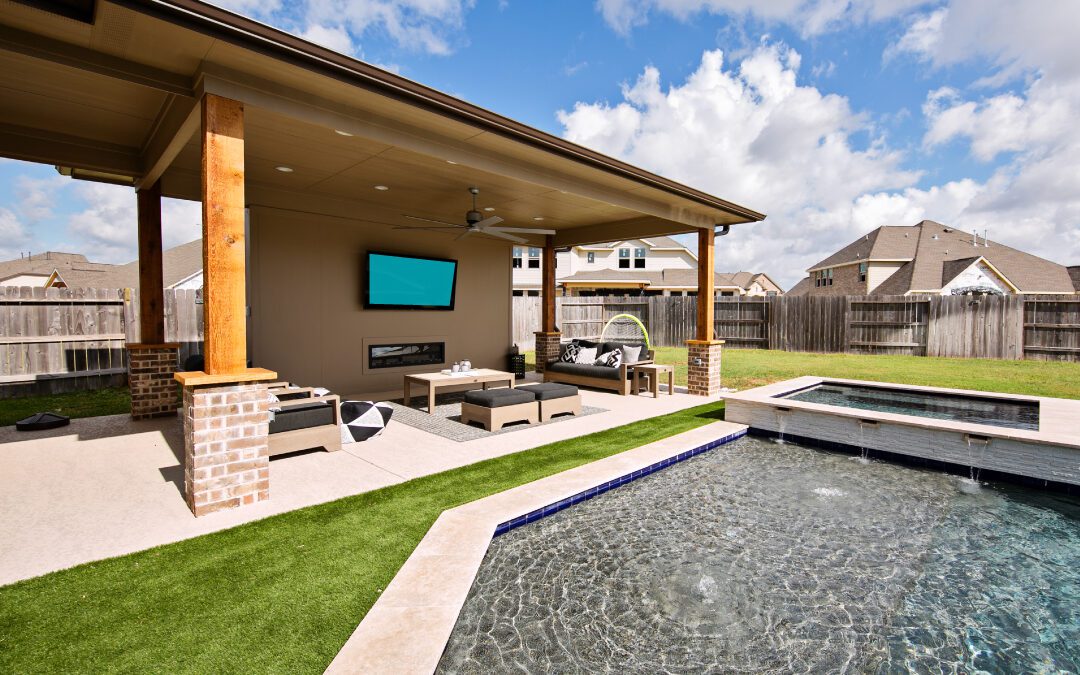Installing an outdoor TV by your swimming pool for poolside entertainment is a great way to improve your outdoor area, combining indoor coziness with outdoor charm. It’s perfect for parties, family time, or just relaxing in your own space. However, picking a waterproof one is crucial since outdoor TVs face different weather conditions. These TVs are made to withstand the weather while still offering excellent viewing. Consider durability, picture quality, and size when choosing a suitable outdoor TV to ensure a fun and lasting outdoor entertainment experience.
Why add a waterproof TV to your pool and patio?
Including a waterproof TV in your pool and patio area offers immense entertainment value, significantly enhancing the overall enjoyment of your outdoor space. Picture yourself relaxing in the pool or spa while indulging in your favorite shows, movies, or live sports on a waterproof TV near the poolside. This addition transforms ordinary poolside and backyard experiences into extraordinary ones.
Investing in a waterproof TV may be considered a luxury, but it introduces a whole new level of leisure to your pool and patio area. Whether hosting events, enjoying a BBQ with friends, watching a big sports game, or having movie nights under the stars, the TV becomes a focal point of entertainment, adding a touch of indulgence to your outdoor space.
Moreover, if your pool has convenient automation systems for managing its operations, you can also take control of your entertainment. Seamlessly integrating the TV’s functionality with your pool’s automation system, you can control the TV’s power directly from your poolside, making it even easier to enjoy entertainment in your outdoor oasis. This integration empowers you to create the perfect outdoor entertainment experience with just a touch of a button.
Selecting the Perfect Outdoor TV
Choosing a suitable outdoor TV is essential for upgrading your outdoor space. These TVs shield internal parts from moisture and weather while defending against dust, humidity, and extreme temperatures. Unlike indoor models, outdoor TVs are designed to handle external elements, offering durability and excellent screen quality.
Outdoor TVs are constructed with materials and coatings that resist rust, corrosion, and sun damage, ensuring they endure various weather conditions like cold, heat, dust, UV rays, humidity, and moisture. Special coatings protect against moisture, dust, and insects, keeping the unit functional and attractive despite weather changes. The IP rating shows how well the TV resists solids and liquids, with a higher rating meaning it’s better at resisting water and dust, which is essential for outdoor TVs. Safety accreditations testify to the TV’s quality and suitability for outdoor use, ensuring it meets specific safety and performance standards, including waterproofing. Look for certifications such as IP ratings and UL listings for outdoor use to guarantee the TV’s ability to withstand outdoor conditions safely and durably.
Locations: Where to Install Your Outdoor TV?
The placement of your outdoor TV significantly impacts its usability and performance. Direct sunlight can cause overheating and glare, affecting your viewing experience. So, what are some effective strategies to minimize the adverse effects of solar rays and heat?
Mounting your TV in a location that avoids direct exposure to UV rays, especially during peak sunlight hours, is advisable. It might entail choosing a shaded area or positioning the TV at an angle that minimizes sun exposure.
For areas where direct sunlight is unavoidable, consider opting for outdoor TVs with high brightness levels and anti-glare screens. These features greatly enhance visibility and comfort, even in bright sunlight.
One popular option is to place the TV poolside, strategically positioning it within your line of sight while you relax in the water. For instance, you could position the TV so it’s easily visible from the spa, pool loveseat, or tanning ledge while ensuring you can hear the audio.
Another common choice is to install the TV within a covered structure, such as a swim-up bar or outdoor living room. These structures offer protection from the sun’s glare and ambient heat or cold and shelter from precipitation.
Additionally, if the structure has full or partial walls, it can help buffer noise from nearby activities, such as splashing in the pool.
In regions with gentle climates, homeowners prefer indoor TVs in sheltered areas to save money, opting to swap them out every few years rather than initially investing in more costly outdoor options.
Guarding Your Outdoor TV
Waterproof TVs are designed to handle poolside and outdoor conditions like splashes and humidity, ensuring they last longer than regular TVs. However, you must protect your device to watch TV near the pool or spa. Here are some tips.
Guarding against moisture – Outdoor TVs require protection from moisture and harsh weather to maintain their functionality and lifespan. This safeguarding is essential for ensuring that the unit performs well over time.
Sealing and covering – It is essential to Seal all cable connections tightly to prevent water damage. Additionally, when the TV is not in use, weatherproof covers or enclosures are necessary to shield it from rain, snow, dust, and debris, thus prolonging its lifespan. If the TV is mounted beneath a protective roof, such as within an outdoor kitchen, the cover may not be necessary due to the added shelter provided.
Additional protection from the elements – Consider installing a small awning or canopy over your outdoor TV if it’s not housed in a protective structure. These additions provide extra protection from rain and can reduce sun glare, enhancing your viewing experience. Anti-glare screens are available to improve visibility further and can be fitted to your outdoor TV to protect against solar glare. Additionally, positioning the TV to minimize direct sun exposure, especially during peak hours, helps reduce glare and ensures enjoyable viewing throughout the day.
About the Author

Hans Joakim Cederlund
Co-Owner, EcoWorks Pools & Outdoors Chair & President, Swedish-American Chamber of Commerce – Texas
Hans Joakim Cederlund is the co-owner of EcoWorks Pools & Outdoors, a premier Texas-based company specializing in complete backyard transformations—from custom-designed pools to luxurious outdoor kitchens and living spaces. With over two decades of executive leadership in the real estate and construction sectors, Hans brings a wealth of knowledge, vision, and hands-on expertise to every project.
Hans holds a Bachelor’s Degree in Marketing and Economics from IHM Business School, and is currently serving as the Chair and President of the Swedish-American Chamber of Commerce – Texas, a role he’s held since 2016. His leadership and strategic insight have helped bridge business and cultural connections across continents.
At EcoWorks, Hans champions customer satisfaction and long-term value, ensuring every outdoor space not only meets but exceeds expectations. His blog contributions reflect his commitment to innovation, craftsmanship, and the transformative power of outdoor living.

